#levee failure
Explore tagged Tumblr posts
Text
Hurricane Katrina: The Storm That Shook a Nation
On August 29, 2005, Hurricane Katrina struck the Gulf Coast of the United States, forever altering the lives of millions and becoming one of the deadliest and costliest natural disasters in American history. Its legacy lives on in the stories of survival, the rebuilding of entire cities, and the lessons learned in disaster preparedness and response. This article explores the devastating impact of…
#disaster preparedness#FEMA#Gulf Coast disaster#hurricane katrina#hurricane response#levee failure#Natural Disasters#new orleans
0 notes
Text
Have you played the Star Ocean First Departure and Second Story remakes? They're also on the Switch and pretty kickass, though they're not quite as lengthy.
People tend to say the first one can be completed in 20 hours, but I'm already at that point and still fucking around like halfway through the story because I will BREAK this skill system as hard as I possibly fucking can.
...Also I wanna know how the story changes when you recruit other characters. I've got a grizzled old Cat Man Dad this time, but I need to see about the Shirtless Beefy Cat Man Swordsman that's available earlier and apparently if you get neither, you can pick up the Twin Swords Cat Lady with the Bisexual Haircut instead. ^-^
I find i'm at my most efficient when i have a hundred hour jrpg to get through on the side. something like my usual map game strategy junk gives me tetris brain styled zero focus hell where i don't get up to anything good, a solid but shorter closed experience game is over too quick to incorporate itself into my routine so i can't dangle it as a consistent reward carrot, but when i have a long ass jrpg is when i'm operating at maximum efficiency because i can start scheduling every event in my day down to the precision of all 96 15 fifteen minute blocks and i can stack them up like bricks and i know exactly when my breaks are and what im doing as my reward for getting things done and what im going to be doing every second and i can maintain that schedule for like three months before i enter hell again.
#If you do get either of them#Save your skill points and max out Determination first when you get it. It makes all the other skills cheaper to level up.#Then when you get the skill that makes it easier to level up the characters go hard into that one.#You'll end up with a Specialty that gives you the option to lower your stats to get even more EXP per fight#And if enough party members know that Specialty you get another one that also lowers your stats in exchange for more Skill Points each leve#Having both on makes some random encounters tough as fuck though#But it's kinda nice to have a random encounter have the same intensity as a boss fight#It makes powerlevelling fun.#And I've barely even dabbled in the item crafting skills which are equally insane.#I did get incredibly lucky figuring out the Customize ability#And somehow wound up with a sword that's like a tier higher than anything available at the current moment.#Everything else came out as crafting failure trash.
67 notes
·
View notes
Text
Horse Story Interstitial
I have an incredibly bonkers Michael Story in the works for you all, but my health is utter crap right now, so it will be a few days before I get it all written. This post is just for a little housekeeping, to answer some questions I've received. Yes, all of the Michael stories are true. Completely factual. He was, indeed, a real horse*, who really was Like That. I did indeed call the now King of England 'Chuck', to his face, and did make fun of his shitty riding. Any other dialogue in these stories, though, is probably not exactly word for word, what was said. It's been 40 years, and I have brain damage, so my memory for that sort of thing is fuzzy. * for dubious values of the word "horse" There have been requests for more pictures, but due to the Great Levee Failure of 05 (also known as Hurricane Katrina), I have a grand total of two pictures of Michael, both blurry, grainy, unposed, and crappy in every possible way. I've scoured the internet, but have found nothing, not even a mention of us. Our career, and our time together, was regrettably short, and it was the 80s, so no records seem to have made it to the digital age. Why do I keep plugging my Kofi and begging y'all to reblog my pinned post? Well. I am disabled and can't work, partially due to the riding accident that ended my equestrian career.
Last year, my husband lost his job of 10 years when the CEO was arrested for embezzlement, gun charges, threatening an FBI agent and his family, and assorted other crimes. The offices were raided by the FBI, and everyone was abruptly fired. He was unemployed for 5 months, and it took us quite a while to dig out of that financial hole. And then the day after the election, my husband was laid off from his new job. Two days later, our beloved cat Commodore Spy Boy Captain of the SS TinyMan went into a coma and nearly died. He spent nearly a week in the emergency pet hospital, diagnosed with pancreatitis and diabetes. $8000+ of vet visits, tests, medications, etc. later, and our credit cards were maxed out, our meager savings were gone, and our credit score was in the gutter, keeping us from getting a second mortgage, or loans, or anything else to help us keep going.
The Commodore is doing fine, though, which makes it all worth it in the end. SpyBoy is my soulmate, my buddy, my constant companion. We're now on month eight of the husband being unemployed. We've got food stamps, which helps. J has been applying everywhere, including the local grocery store and convenience stores. I've been selling my library of signed and rare editions. I've been taking commissions for the costume pieces I make, and offering tarot readings. And it's just not enough. We have bills coming up in a week, and no way to pay them. We're in serious danger of losing our house, which would leave us homeless. So that's why I've been asking for help and reblogs. I am so, so grateful for everyone who has reblogged our fundraiser post and donated to the Kofi. Y'all are my heroes. There are at least a few more Michael stories still to come. The next one is a doozy. Thank you all for reading, commenting, and asking questions. It's wonderful that you have all adopted my demon horse into your hearts. I miss him, love him, and will never forget him.
67 notes
·
View notes
Text
"Trump supporters say, 'We suffered 8 years under Barack Obama.'
Fair enough. Let’s take a look.
The day Obama took office, the Dow closed at 7,949 points. Eight years later, the Dow had almost tripled.
General Motors and Chrysler were on the brink of bankruptcy, with Ford not far behind, and their failure, along with their supply chains, would have meant the loss of millions of jobs. Obama pushed through a controversial, $80 billion bailout to save the car industry. The U.S. car industry survived, started making money again, and the entire $80 billion was paid back, with interest.
While we remain vulnerable to lone-wolf attacks, no foreign terrorist organization has successfully executed a mass attack here since 9/11.
Obama ordered the raid that killed Osama Bin Laden.
He drew down the number of troops from 180,000 in Iraq and Afghanistan to just 15,000, and increased funding for the Department of Veterans Affairs.
He launched a program called Opening Doors which, since 2010, has led to a 47 percent decline in the number of homeless veterans. He set a record 73 straight months of private-sector job growth.
Due to Obama’s regulatory policies, greenhouse gas emissions decreased by 12%, production of renewable energy more than doubled, and our dependence on foreign oil was cut in half.
He signed The Lilly Ledbetter Act, making it easier for women to sue employers for unequal pay.
His Omnibus Public Lands Management Act designated more than 2 million acres as wilderness, creating thousands of miles of trails and protecting over 1,000 miles of rivers.
He reduced the federal deficit from 9.8 percent of GDP in 2009 to 3.2 percent in 2016.
For all the inadequacies of the Affordable Care Act, we seem to have forgotten that, before the ACA, you could be denied coverage for a pre-existing condition and kids could not stay on their parents’ policies up to age 26.
Obama approved a $14.5 billion system to rebuild the levees in New Orleans.
All this, even as our own Mitch McConnell famously asserted that his singular mission would be to block anything President Obama tried to do.
While Obama failed on his campaign pledge to close the prison at Guantanamo Bay, that prison’s population decreased from 242 to around 50.
He expanded funding for embryonic stem cell research, supporting ground breaking advancement in areas like spinal injury treatment and cancer.
Credit card companies can no longer charge hidden fees or raise interest rates without advance notice.
Most years, Obama threw a 4th of July party for military families. He held babies, played games with children, served barbecue, and led the singing of “Happy Birthday” to his daughter Malia, who was born on July 4.
Welfare spending is down: for every 100 poor families, just 24 receive cash assistance, compared with 64 in 1996.
Obama comforted families and communities following more than a dozen mass shootings. After Sandy Hook, he said, “The majority of those who died today were children, beautiful little kids between the ages of 5 and 10 years old.”
Yet,
he never took away
anyone’s guns........
He sang Amazing Grace, spontaneously, at the altar.
He was the first president since Eisenhower to serve two terms without personal or political scandal.
He was awarded the Nobel Peace Prize.
President Obama was not perfect, as no man and no president is, and you can certainly disagree with his political ideologies. But to say we suffered?
If that’s the argument, if this is how we suffered for 8 years under Barack Obama, I have one wish:
may we be so fortunate as to suffer 8 more."
by Teri Carter, Lexington Herald-Leader

#obama administration#obamacare#barack obama#michelle obama#president obama#obama#44#barack hussein obama
27 notes
·
View notes
Text
Supernatural Revisited: 5x12 Swap Meat
Swap Meat is another stand-alone monster-of-the-week episode, but in spite of it mostly being filler, it functions as a thematic sibling to its predecessor 5x11 Sam, Interrupted. In that episode, Dean and Sam were 'going crazy', i.e. losing control of their minds as the wraith manipulated their neurochemistry in order to make their brains tastier. In this episode, Sam's body is taken from him in order to get to Dean. In the context of the whole show, this is relevant to Dean and Sam as vessels for Michael and Lucifer respectively, and the possibility they will soon have to surrender control of their bodies and minds. The link is perhaps tenuous and nothing much happens in the episode which has bearing on the show later, but at least the filler has a bit of meaning and relevance.
In general, 5x12 Swap Meat is a fun episode with some nice character moments from both Dean and Sam. The sheer stupidity of the children was unfortunately to the episode's detriment, being rather an easy way out of the plot. Quite apart from tranquillising a man in broad daylight in the middle of a street, what level of stupid does it require to goad a demon like the blond boy did? He had as much ability to compel and control her as a fly does a tarantula, yet seemed quite content to run his mouth off. On the one hand, children completely lack foresight and caution, but the stupidity felt too much like an excuse for the plot to happen.
youtube
As much of a surprise as it might sound, I actually generally liked Sam in this episode (with the caveat that after 4x21 When the Levee Breaks he is irredeemable). The amount of sniping at Dean was so minimal I do not remember it, and the fact he spent most of the episode away from Dean allowed him to be his own person and actually do something by himself.
That said though, I do not understand his derisive use of the word 'virgin' when picking up Gary's Star Wars t-shirt. Gary is 16 or 17 in this episode, so is it weird, unusual, or scoff-worthy that he is (supposedly) yet to make the beast with two (or more) backs? He is a child, so why is this a) noteworthy and b) a bad thing? I do not get it. I also do not know how Star Wars merchandise correlates with a lack of sexual experience. Of course I understand that calling a man (or even a pubescent boy) a 'virgin' is essentially calling him a failure as a man because not being desirable to women = not a real man but I generally thought this was stupid. ...As well as weird in bringing up a child's sexual prowess or lack thereof.

Apropos sexual prowess, Gary hijacked Sam's body and used it to have sex with the woman he picked up in the bar. The viewer is, of course, supposed to laugh at this, but it brought to mind a similar story from Buffy when Faith body-swapped with Buffy and had sex with Buffy's boyfriend Riley while in Buffy's body. This was not played for laughs in any way, but the situation was not treated that well in Buffy either (how was Riley to know Buffy was not Buffy? He was not to blame), but the situation touched a nerve in the viewership so much that Mark Field's book Buffy the Vampire Slayer Myth, Metaphor, and Morality had quite the discussion of it.
youtube
(The video should start at 5:40)
Gary had sex with an older woman while in Sam's body, i.e. he made Sam's body engage in sexual intercourse without Sam's knowledge or consent. He also made the woman unwittingly have sex with a 16 or 17 year old, something I expect would horrify her if she knew. I also doubt we would be encouraged to see Gary's behaviour as silly shenanigans if he were a 16 year old girl doing the same. If fact, we would probably be encouraged to wonder what damage it had done to her perception of sex and relationships.
The viewer is of course supposed to see this as a sexual conquest for Gary which is also a little bit funny because he is inexperienced, but for it to be funny you need to discount all that stuff above and I unfortunately remain unable to do so.
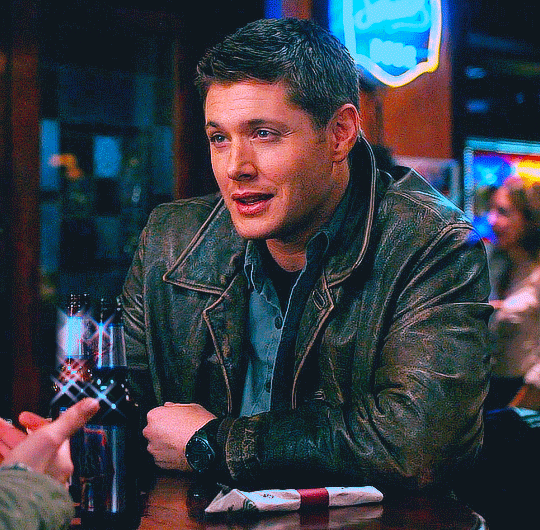
In spite of being a complete idiot, Jake did give Dean a bit of validation in telling him he is a good guy, something Dean probably has never heard from anybody. That a teenage boy trying to kill him should be the one to say it says a lot about Dean's circumstances.
The episode proper begins with Dean and Sam talking to a woman who sometimes babysat for them when they were young. Bearing in mind the flashbacks in 1x18 Something Wicked and 3x08 A Very Supernatural Christmas, it irritates me that the babysitter claims John loved Dean and Sam. Yes he did (although whether or not he loved Dean is up for debate), but that does not mitigate the fact he left them alone for days or weeks at a time with little food, no money, and no protection from monsters. In fact, he used them as bait. It would be lovely if the show could stop trying to erase what John did and just embrace it. The fact that there was at least one person other than Bobby, Pastor Jim, and Caleb who could have looked after Dean and Sam when they were abandoned in motels just makes the situation worse.
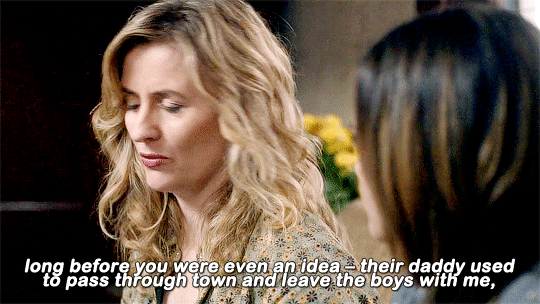
But regarding the babysitter, Dean and Sam's visit shows them how well she is doing for herself with a husband, a daughter, and a house millennials can only dream of. This precipitates a conversation about whether or not Sam wants a normal life, in which Sam reveals that he does not want that anymore. Or at least says he does not. Since this is a kind of life Sam never knew in the first place, it is perhaps believable he would not feel a particular draw to it. It is quite the contrast to the earlier series when he hoped to go back to Stanford after getting revenge on Azazel. It is also perhaps not that true, since Sam jumps at the chance for a 'normal' life in the space between series 7 and 8. The viewer will also find out in a few episodes' time that the best time of Sam's life was when he ran away from John and Dean and spent a while with a 'normal' family.
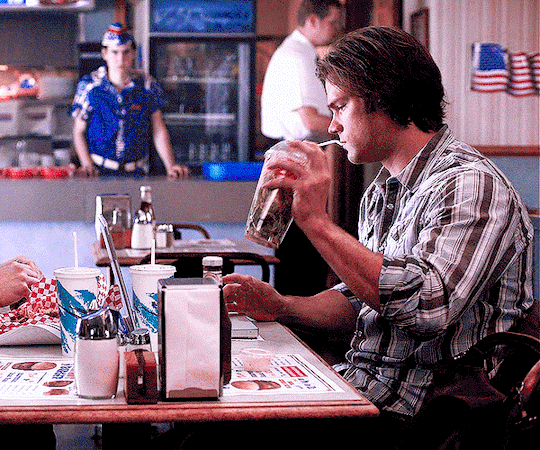
Jared is on record as saying he did not want Sam to have a life in hunting. Jared's preferred ending (or so he says) seems to be the very ending he was given in the 'canonical' ending 15x20 Carry On.
Dean asking the question implies that the thought is in his mind, which should come as no surprise. Since he was four years old, his entire life was put on hold for John's crusade. Dean sincerely wants a boring suburban life but is perhaps too damaged to ever be properly functional in that situation again. I will discuss this in more detail at the beginning of series 6, but Dean needs somebody who is a hunter or hunter-adjacent to make a life with. In the end, Cas was the only one it could have worked with.
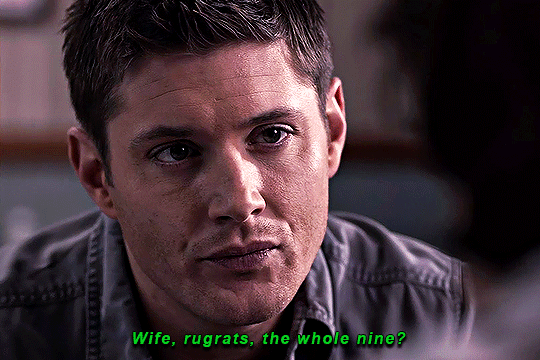
A side-note: Supernatural's official Youtube channel is now acknowledging Destiel, the official Supernatural podcast Supernatural Then and Now has reached 6x20 The Man Who Would Be King and also acknowledging and validating Destiel.
Ben Edlund has talked about being told to remove subtext, and Jensen has said Cas's love for Dean is not subtext, but rather actual unignorable text. The original ending of the show was supposed to have Dean and Cas in Harvelle's Roadhouse in heaven with Dean's arm around Cas. After years of mockery, gaslighting, and hostility from fellow fans and people on the show, it is gratifying to finally be proven not insane. Almost as if we were not 'reading too much into it' or 'pushing a narrative'. Perhaps if the show is ever revived in some form, Dean might finally get the life he longed for, but with Cas.
Before finishing, a little bit of lore Paula discussed was the fact that the demon wanted to take Gary to Lucifer means that Lucifer does not need Sam to say 'yes', just the person in Sam's body. She concluded that this would give Sam an possible escape from being Lucifer's vessel, if Sam could somehow find a way to leave his own body and find another. This would have been an intriguing plot to follow and could have resulted in Sam -- AND Dean -- becoming active agents in the Apocalypse rather than being puppets. Unfortunately, that is not the plot the show gave us.
Moreover, the fact that Dean did not finish the exorcism ritual properly but was still successful heavily implies that the language used in magic is not actually important. This means that the exorcism could be entirely in English and it should work.
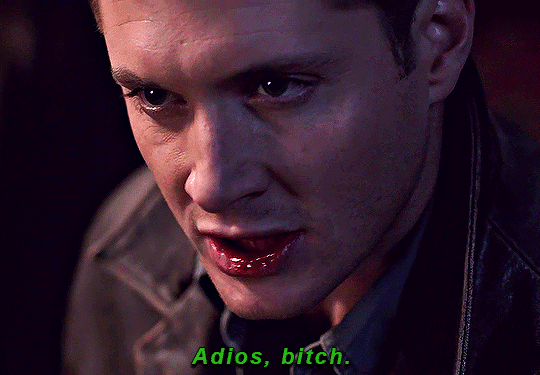
Thus concludeth the analysis.
You can read more of my analyses here:
Series 1
Series 2
Series 3
Series 4
Series 5
Sundry
You can read Paula’s review here and TwP’s here.
#edvard's supernatural guide#supernatural revisited#spn 5x12#swap meat#s05e12#spn meta#supernatural#meta analysis#spn#dean winchester#sam winchester#bi!dean#destiel
8 notes
·
View notes
Text
Chaos in Cakesland characters :D

OCs who have been invading my mind since 2022
"In Cakesland, the country of sweets, people suddenly start developing a disease that makes them eat one another. After a series of unfortunate events, Pilóta, a young girl joins an organisation of outlaws who are trying to improve their world by finding the cure."
Yes they're all based on baked goods and cookies. Back then I was desperately trying to come up with a story to write, got frustrated that none of my ideas came out right, and decided to fuck it, and created some OCs out of cookie puns. Because I can.
The whole concept is just a bunch of tropes I liked, smashed together into one weird story. It's like baking, in a way.
The plot has changed a LOT since its creation, and it will keep on changing probably every time I get into some new piece of media.
For those who might care, some info about the characters:
-Pilóta: the main character, young, sheltered kid who's out in the real world for the first time. Tries to help best as she can, but has to overcome her massive fear of failure. Comes from a noble family who placed high expectations on her, ones she couldn't meet. Hopefully through the journey she'll become someone her family can be proud of.
-Levi (gyümölcs leves): Sort of the leader of the group, at least he claims he is. The brains, the one who comes up with the plans. Has been really into science since the disease broke out, but honestly? Kind of a poser. Regarded as the "weird kid" in his youth, but he didn't let it get to him. Levi wants to have everything under control at all times, after all, only he knows what's good for him and the situation he finds himself in. Has to learn to let others take the lead.
-Gombi (szilvás gombóc): The charismatic one in the group. Silver tounge, great performer, excellent manipulator. Despite her poor upbringing, she managed to get a name in the entertainment industry due to her talent and aura. Always jumping from on experience to the other, Gombi has to learn to deal with her problems instead of distracting herself all the time.
-Linzer: The brawns of the group, the muscle. Great in combat, not so much in anything else. Especially at being humble. This guy was titled the "city's hero" at the start of his carreer, and though it's been a long while since he'd last been referred to as such, he still believes he's entitled to carry out judgement in the name of the greater good. Which is to say, he views the world in black and white, no gray areas. He really needs to work on that.
Yup. I like and think about these guys a normal amount, I think.
#oc#original character#orczy#chaos in cakesland#that's right I'm making a tag for my story as if it were a fandom#I am so very normal about them#Extremely so
7 notes
·
View notes
Text

"Trump supporters say, 'We suffered 8 years under Barack Obama.' Fair enough. Let’s take a look:
▪️The day Obama took office, the Dow closed at 7,949 points.
▪️Eight years later, the Dow had almost tripled.
▪️General Motors and Chrysler were on the brink of bankruptcy, with Ford not far behind, and their failure, along with their supply chains, would have meant the loss of millions of jobs. Obama pushed through a controversial, $80 billion bailout to save the car industry. The U.S. car industry survived, started making money again, and the entire $80 billion was paid back, with interest.
▪️While we remain vulnerable to lone-wolf attacks, no foreign terrorist organization has successfully executed a mass attack here since 9/11.
▪️Obama ordered the raid that killed Osama Bin Laden.
▪️He drew down the number of troops from 180,000 in Iraq and Afghanistan to just 15,000, and increased funding for the Department of Veterans Affairs.
▪️He launched a program called Opening Doors which, since 2010, has led to a 47 percent decline in the number of homeless veterans. He set a record 73 straight months of private-sector job growth.
▪️Due to Obama’s regulatory policies, greenhouse gas emissions decreased by 12%, production of renewable energy more than doubled, and our dependence on foreign oil was cut in half.
▪️He signed The Lilly Ledbetter Act, making it easier for women to sue employers for unequal pay.
▪️His Omnibus Public Lands Management Act designated more than 2 million acres as wilderness, creating thousands of miles of trails and protecting over 1,000 miles of rivers.
▪️He reduced the federal deficit from 9.8 percent of GDP in 2009 to 3.2 percent in 2016.
▪️For all the inadequacies of the Affordable Care Act, we seem to have forgotten that, before the ACA, you could be denied coverage for a pre-existing condition and kids could not stay on their parents’ policies up to age 26.
▪️Obama approved a $14.5 billion system to rebuild the levees in New Orleans.
▪️All this, even as our own Mitch McConnell famously asserted that his singular mission would be to block anything President Obama tried to do.
▪️While Obama failed on his campaign pledge to close the prison at Guantanamo Bay, that prison’s population decreased from 242 to around 50.
▪️He expanded funding for embryonic stem cell research, supporting ground breaking advancement in areas like spinal injury treatment and cancer.
▪️Credit card companies can no longer charge hidden fees or raise interest rates without advance notice.
▪️Most years, Obama threw a 4th of July party for military families. He held babies, played games with children, served barbecue, and led the singing of “Happy Birthday” to his daughter Malia, who was born on July 4.
▪️Welfare spending is down: for every 100 poor families, just 24 receive cash assistance, compared with 64 in 1996.
▪️Obama comforted families and communities following more than a dozen mass shootings.
▪️After Sandy Hook, he said, “The majority of those who died today were children, beautiful little kids between the ages of 5 and 10 years old.” Yet, he never took away anyone’s guns........
▪️He sang Amazing Grace, spontaneously, at the altar.
▪️He was the first president since Eisenhower to serve two terms without personal or political scandal.
▪️He was awarded the Nobel Peace Prize.
▪️President Obama was not perfect, as no man and no president is, and you can certainly disagree with his political ideologies. But to say we suffered?
💙 If that’s the argument, if this is how we suffered for 8 years under Barack Obama, I have one wish:
💙💙 ”May we be so fortunate as to suffer 8 more."
by Teri Carter, Lexington Herald-Leader
3 notes
·
View notes
Text
Something about Fighter (that gets way too peraonal real quick)
So, I am currently in what may be my last year of college in a teacher's formation course for the English language, going through the period of obligatory internship in schools per my major’s grade. It has been the most terrifying and anxiety inducing I've had to endure in my life thus far.
I care far too much about people's perceptions of me to be able to take this career/job. I am constantly worried if I'm doing a good job, if I've been behaving properly, if I've been too unintentionally rude or too loose, what the staff thinks of me, what the students think of me, if they think I am someone who has no idea of what she's doing, etc, etc. Which may make you, hypothetical reader, wonder; “Carol, why the hell did you pick a teacher's formation course then?”
Short answer is that I didn't think, the long answer is that in the Brazilian school system we have this thing called ENEM which is essentially an entrance exam for government funded universities (here what I've been calling college equals to university for yall, i just call it college because, eh, force of habit) as long as your grade is high enough and you've finishing highschool. I took the ENEM exam back in 2021 at 16 years old with no idea what I wanted to do with my life so when it came time to pick the course to apply for so i just gravitated towards something I was good at, i like english a fair bit so why not, and ended up making it in, entering college at age 17 and possibly finishing it at 20.
Being completely honest, I never had any real issue with picking up the pace with college work n stuff up until the period of obligatory internships started. For all reasons mentioned above and the added factor that this was nothing for my classmates since they're all way older than me and most already work as teachers anyway, ik I shouldn't compare my young ass self to them but either way makes me feel like I've fallen behind a ton like a complete failure and just wasted the last 3 years of my life on this.
So yeah, if in any conversation between friends, mutuals or hell maybe even tag rambles I've mentioned that “I haven't been feeling well in a while” or something similar, that was the reason! The internships themselves and the fact that by the end of each I have to write this huge ass memorial retelling the experience and every single time it takes me weeks and I cry a river while remembering how absolutely terrible I felt (just to be clear THE PROBLEM IS ME! MY BRAIN!! No supervisor, teacher, student or anyone in these has ever been rude or treated me badly, hell I've even been told I did a good job in some, it's all a me thing that I've been trying to work on) and that made my mental health go downhill last year, to the point I started therapy early this year out of mom’s request after having a meltdown over my profession and teaching during a Christmas praying session, crazy times.
I can't say I'm better, but I am certainly working towards that and today I wrapped up the 3rd obligatory internship period in my course. I can't say I got over my shit and all that inspirational jazz, tbh I cheesed through it a couple times but for someone who wasn't even sure if she'd be able to stay in the school without having a crisis completing the damn thing is certainly a win, even if I don't feel happy about my results, I felt less bad on this one than the last (and as y'all can tell this is mostly me venting haha)
Now, you're probably wondering; “What the hell does all of this have to do with your goofy ass Ena character?”
You see, Ena has always been a huge comfort media to me. I first discovered the series around 2021 while being incredibly fearful and paranoid due to the pandemic to the point I'd hardly ever leave my room or interact with anyone. The surreal weirdest of the show paired with a character that's constantly shifting between being extremely upset and doing just fine resonated with me on a personal level and brought me a genuine comfort that I desperately needed during such a shitty period in my life, hell, I relate to og Ena so much that now as an adult I see even more of my issues on her. Fast forward to late March this year where Dream BBQ finally came out and I got around to playing it at around early April, when the internship period was right around the corner and I should start applying to some school to be at for the time, it's like the universe conspired to bring this beloved piece of media back to me in another rough patch! And this time around I ended up going even more personal and using the bases of an Ena character as an “Outlet”? Of sorts? Maybe more like shaping the whirlwind of emotions spinning inside my head into a character.
So Fighter is nothing more than a very personal little creature that embodies this mess of myself, the uncontrollable crying and feelings of incapability and failure that made me melt into tears on my very first day of the internship and the inexplicable burst of joyful energy I got when I was accepted at the place or managed to keep my cool through the shift. Fear and Courage! Because neither cancels out the others as courage isn't the absence of fear but facing your challenges in spite of it, so the two sides (and they extremes) coexists within me and the character, who is a fighter because of the fact that I will get this goddamn college degree no matter how much I have to fight for it.

So yeah that's why I tag her posts as Enasona, even if she's more like a weird introspective thing rather than behaving like I do irl, y'all get what I mean by this point (hopefully)
#designated character i fall back into when emotions and hardship#to be fair a good chunk of my characters have personal shit of mine into them. like Akira with the memory issues. Beni with irritability#but Fighter is by far the biggest one of them all if you couldn't tell#and the coexistence of the emotions is a big thing of how i portray this character#you can feel fear while doing something brave and you can feel a spark of courage while being scared#you can see in some of my drawings of her that the eyes aren't 100% matching. like both sides exists simultaneously and still emote#a lil differently. it's just that one dominates over the other at times. but they're both there always#wow this post got really long an cringe lmao#hyena ramblings#put ramble on THAT#Enasona#Fighter Ena#vent#personal
2 notes
·
View notes
Text





Book 548
Unfathomable City: A New Orleans Atlas
Rebecca Solnit and Rebecca Snedeker
University of California Press 2013
With the success of Infinite City came the inevitable sequels—Unfathomable City and Nonstop Metropolis for New Orleans and New York, respectively. While very similar to the SF volume, the most interesting parts of this book is that when it was published, New Orleans had recently been the site of two major catastrophes: the BP oil spill and Hurricane Katrina. So, along with maps of Houma migrations and coastal erosion, cemetery relocations, places of interest in the fight for civil rights, the banana trade, seafood and sex work, there are maps of petroleum extraction and how it impacts nature, the failure of the prison system and levees, and the city pre- and post-Katrina. So, while I’ve never been to New Orleans, I feel like this book gives me an insight into a city that previously had only existed for me in jazz dreams, movies, and Anne Rice novels.
#bookshelf#library#personal collection#personal library#books#bibliophile#book lover#illustrated book#booklr#cartography#maps#graphic design#unfathomable city#rebecca solnit#Rebecca snedeker#UC press
5 notes
·
View notes
Text
I found out Spike Lee did a docuseries on Katrina and it’s. Sobering.
I was 16 and in Ohio. We only got the remnants, a shit ton of rain. But I just remember reading the papers and seeing the pictures and it just. It kept going. For weeks, nothing else was above the fold except Katrina aftermath and levees failing and the water never went away.
If you weren’t around or were too young to remember Katrina, you haven’t really experienced a complete failure from every side concentrated like that. NOLA still hasn’t recovered. Most of the Gulf Coast still hasn’t recovered. There’s still houses with the FEMA crosses on them, never demolished or taken care of—probably still with their residents remains inside.
Watch When The Levees Broke
12 notes
·
View notes
Text
wbgu snippet, ch 13
First draft, still rough in a few spots.
Enjoy!
They arrive in Baton Rouge and pull up to a simple, cozy looking home, lights on inside despite the time. Catarina protests a little as they climb out of the car, exhausted, as Alastor and his dad take care of the luggage. They’ve packed a few days’ worth, enough to last until the hurricane blows over and they go back.
The front door opens before his dad can knock.
“Aunt Sabrina,” Catarina says sleepily, reaching out for a hug. Aunt Sabrina laughs quietly, pulling Catarina into her arms. “Same room as you always take, Val and I got it ready for you.”
“Thank you so much,” his dad says, and Aunt Sabrina rolls her eyes.
“You’re family,” she says, placing a hand on his arm. “No thanks needed.”
“We appreciate it anyway,” Alastor’s mom says, leaning in for her own hug. “Especially on such short notice.”
“I would’ve insisted anyway. They say this one’s gonna be bad, and I’d hate myself if I let my little brother and his family stay and you got hurt.”
Exhausted, Alastor takes the luggage and leaves the adults talking, heading down the hall to the room they normally stay in when they visit.
×
Alastor tries to listen to the adults talk about the hurricane over breakfast over the chatter of his annoying cousin, but the only thing he catches is, “Category 3 now,” from his father.
×
“They issued mandatory evacuation warnings,” Aunt Sabrina says to his parents.
“Not for our parish,” his mom responds. “Only voluntary, so far.”
“So far,” his dad adds, eyebrows furrowed.
His parents argue about it, but his dad eventually wins out on the argument about whether or not to turn the television on. They make a compromise, keeping it at a low volume.
×
It’s a little after midnight when Alastor gets up to use the bathroom. The television is still on in the living room, volume low. He catches “—Category 4 storm—” just before the TV is turned off.
×
“It just got bumped up to Category 5,” Alastor’s dad says in low tones. “I’m worried—and so many people are unable to evacuate…”
“Hurricane Ivan was Category 5 too, wasn’t it?” Aunt Sabrina responds.
“Yes, but it made landfall much further east,” his dad says. “This is—the projections are for it to hit New Orleans head on, and that’s—that could be catastrophic, Sabri. Especially with the storm surge—even if it doesn’t hit land at that intensity, the surge will still be the same.”
“Well, at least you’ve got the levees,” Sabrina says with a small smile. “Made for this kind of thing, weren’t they?”
Alastor’s dad hesitates. “Yes,” he says quietly. “Yes, at least we have those.”
×
Monday, August 29th, 2005, Hurricane Katrina makes landfall in New Orleans.
To herald in her arrival, nine feet of storm surge rush in to meet the city, slamming into a portion of the levee in the Industrial Canal. The levee is overwhelmed, and the waters rush in.
The gulf’s waves rage against the western shores, tearing at the levees, the city’s protectors to the east.
Ahead of landfall, a second rush of storm surge leads with Katrina on its back.
The eastern levees fail, and eighteen-feet of storm surge overtops them, ripping through St. Bernard Parish as it rushes onward to the Lower Ninth Ward.
Katrina brings with her another surge as she reaches the shore, nearly twenty more feet of water meeting the previous arrivals in the Funnel, where the levee systems converge.
With the years of loss of the protective wetlands that helped keep the city safe, the man-made levees stand no chance, and twenty minutes later, the surge overtops the Funnel.
The Industrial Canal levees, still working to keep Katrina’s floodwaters at bay, are soon overtopped. The Lower Ninth Ward begins to fill.
Its fate is sealed when the levee is destroyed, twenty feet of water washing away everything in its path.
Homes become coffins as neighborhoods become graveyards.
An hour later, London Avenue Canal fails the first time, shoving houses from their foundations.
The second failure brings with it another eight-feet of water.
The 17th Street Canal collapses.
The city drowns.
9 notes
·
View notes
Text
Vidal [...] emphasizes the close relationship that existed between the Louisiana settlement [at New Orleans] and the Caribbean island [Haiti, the colony of Saint-Domingue] during the former’s French colonial period (1718-69). It has become a bit of a popular adage to describe New Orleans as the northernmost port of the Caribbean, but Vidal’s Caribbean New Orleans: Empire, Race, and the Making of a Slave Society demonstrates the substance behind these claims. [...] New Orleans is the missing link, a late-forming city that largely inherited its founding ideas, practices, peoples, plants, and laws from its longer-established imperial neighbors [France, Spain, Britain, and what would become the United States]. It thus offers the ideal case study in which to consider how colonies around the Americas developed in conversation with one another [...].
Vidal convincingly argues that New Orleans was a “slave society,” or a settlement in which racialized slavery informed every part of everyday life from its inception, whose physical construction was done alongside the “construction of racial categories” (p. 1).
This is an important shift within Louisiana historiography, which has long stood by [...] [the] argument that early New Orleans offered the semi-unique example of a “slave society” devolving into a “society with slaves.” Abandoned by the French following the spectacular failure of the Compagnie des Indes, the standard story goes, New Orleans became an isolated backwater until the 1770s, struggling to survive and permitting, out of sheer need, less disciplined contact between residents of European, Indigenous, and African birth and descent. [But] Vidal, in contrast, shows that, while Louisiana struggled to create a full-fledged plantation economy during the French era, this did not prevent its capital from organizing itself along the highly stratified lines of the Caribbean islands.
---
Furthermore, she argues, because New Orleans did not see many new residents after 1731, free or enslaved, and because it was a smaller settlement, white inhabitants were able to build upon these ideas in a relatively stable environment - focusing much of their energies on surveilling, containing, and disciplining the enslaved and free persons of color (p. 26). [...]
Vidal especially points to the 1729 Natchez attack and ensuing Natchez Wars [against Indigenous peoples] as pivotal moments in the militarization of white New Orleanians [...].
Subsequently, a scrupulous supervision of racial boundaries became the norm for the rest of the French era and fostered “a sense of community among white urbanites” (p. 141). Chapter 3 takes readers to the streets, levees, and other public spaces of New Orleans, where whites sought to sculpt the privileges of “whiteness” against both residents of African birth and descent as well as one another. Elite men and their wives scuffled over the best seating at church in an effort to recreate France’s ancien régime culture; socially lower [...] nonslaveholders, meanwhile, carefully guarded their weaker claims at mastery through street violence [...]. Beginning with a careful reading of census categories, Vidal traces how distinctions between European settlers [...] were increasingly replaced with those centered exclusively on race by 1763. [...] [Vidal then] follows the ways in which the demographically diverse workforce of the early colony made up of white indentured servants, convicts, and soldiers in addition to enslaved Africans - gave way to associations of difficult and degrading labor limitedly with the enslaved. [...]
---
French Louisiana inherited racial categories from the Caribbean but adjusted them to fit local needs, experiencing “not so much a loosening, but a more complex transformation” of its racial regime, largely through violence (p. 371).
Vidal documents how the Superior Council utilized targeted prosecutions and punishments to increasingly “imprint terror and instill obedience” on the enslaved (p. 390). [...] [The book] thus details a society in which racial hierarchies were asserted and supported through both top-down and bottom-up policies and practices, as “no social institution or relationship was left untouched by race” (p. 504).
To this end, Vidal speaks to important conversations by historians of enslaved women in the British Caribbean, including Jennifer Morgan and Marissa Fuentes. These authors have used a similarly wide range of sources [...] [and] archives to underscore the invasive nature of colonial racism. [...] [I]n part [...] Vidal’s [chapters work] to decouple lower Louisiana history from the fur traders of New France [Ontario, Quebec, and the watershed of the Mississippi River] and to reattach it to the planters of Saint-Domingue [in Haiti and the Caribbean]. [...] Combing through administrative papers, censuses, laws, parish registers, correspondence, and judicial records from both sides of the Atlantic, readers will get a sense that there is little Cécile Vidal has not seen or considered. [...] Her book [...] hopefully will convince an even wider audience [...] [to engage with] comparative, cis-Atlantic, and transatlantic studies of imperialism, race, and slavery.
---
All text above by: Kristin C. Lee. "Review of Vidal, Cécile, Caribbean New Orleans: Empire, Race, and the Making of a Slave Society". H-Atlantic, H-Net Reviews. January 2022. URL at: h-net dot org/reviews/showrev.php?id=56913 [Bold emphasis and some paragraph breaks/contractions added by me. Presented here for commentary, teaching, criticism purposes.]
#tho american louisiana 1805ish to 1865 was obviously brutal slave society and an epicenter of US slavery vidals book makes case that#earlier french new orleans also fundamentally slave society in own distinct ways despite citys reputation as relatively cosmopolitan#and today louisiana now home to cancer alley pollution y fossil fuel pipelines y industrial chemical refineries y prisons built on plantati#300 years of violent racial hierarchy in louisiana wearing different masks#her footnotes are extensive y detailed enough to be a whole other book quite the synthesis#tidalectics#abolition#archipelagic thinking#geographic imaginaries#caribbean#black methodologies#indigenous#indigenous pedagogies#debt and debt colonies#agents of empire
18 notes
·
View notes
Photo

Hinge presents an anthology of love stories almost never told. Read more on https://no-ordinary-love.co
566 notes
·
View notes
Text
I’m reading about support for conspiracy theories on the Left v. Right. And this article is making the case that the left of the political spectrum is as likely to support conspiracies as the right. And then I took a look at the conspiracies they were polling people about.
They provided a graph that plots support for a conspiracy and left v. right affiliation. The “left” conspiracies include “Trump is a Russian Asset” and “Russian disinformation affected the 2016 election” whereas “right” conspiracies include “George Soros controls the world” and “COVID is a Hoax.”
And I’m like???? Hello??? I don’t think these are comparable? Like… yeah, “you are not immune to the propaganda,” but I also did not hallucinate the 2016 election or the countless reports on Russian disinformation campaigns and their affect on our election. I also distinctly remember our intelligence community labeling Trump a “Russian Asset” for his friendliness with Putin’s regime and tendency to— like— give him delicate information.
I don’t think you can claim, “Liberals are just as likely to believe in conspiracies, if not more so, than Conservatives” when you list things like, “The CIA interfered in Chilean elections in the 1950s, 60s and 70s” as a conspiracy. You should be listing things like, “Bush blew up the levees,” not “Partisanship was a factor in the Bush Administration’s anemic response to Katrina.” One is a conspiracy. The other is a conclusion based on 20 years of political analysis.
Now, granted, they also listed things like “Trump lied about having COVID” and “Putin poisoned Hillary Clinton,” but they also included things like “The Reagan Administration’s failure to address the HIV/AIDS epidemic killed people.”
And… ummm. Those aren’t comparable beliefs.
Where is the analysis of how likely a liberal is to believe in “lizard people” “controlling” the government?
9 notes
·
View notes
Note
HEHE OK!! Here's my current fic dumping:
Takes place like... Just after the cover story where NEO-MADS formed, semi-during Wano (though Wano events are p much irrelevant, its just a timeframe). Levely ig also going on which IS funny to me because. The fact that the one Levely we see is the very first one Germa doesn't get invited too is crazy. Vivi has probably met the Vinsmokes once. They would be as problematic and unhelpful as Wapol is.
ANYWAY! Germa is trying to restore itself after Whole Cake Island, and Caesar is specifically currently helping to restore labs and gather supplies for them.
Currently writing in 3rd person Yonji POV just... bc thats what I ended up doing, he's fun to write.
Ichiji is the main one who is kinda... off, after WCI. I read a good post pointing out how Ichiji was probably the one who decided to save his brothers, not Reiju (who mostly just sees them as machines) and I kinda ran with that idea. I have BIG interest in Ichiji being the first to break down, I mean, he's the most PERFECT and emotionless, and the next in line for king, so when he crumbles... what are the others supposed to do?
Though my main original idea here... Judge has that "Soldier Stock Depot". Judge is one of the only characters we know who knows how to clone, the other being Vegapunk himself (iirc). If his greatest experiment (as in, his literal CHILDREN whom he "lovingly" named 0 1 2 3 4) all end up failing him... his greatest failure being the main savior of the WCI incident... well. What's stopping Judge from starting all over, and cloning his little failures to make new ones?
A bad experiment is one with only one, maybe two trials. Maybe Judge even gets inspired after a non-serious, one-off comment from Caesar. Either way, its safe to say the cloning room is off-limits to the siblings again, for some inexplicable reason.
YAAAY :DDD!!!
I think it's so cool you're settting it after neo-mads formation cause I don't think I've read any other fics that include ceasers involvement with the vinsmokes. he's such a silly guy I can't wait to see what kinda chaos he will cause XDc
yonjis POV of post-wci... that's so interesting 👀 I've noticed for people tend to see him as the 'most emotional' of 124ji since he's explicitly silly and horny on-panel, that and being the youngest opens up alot of potential characterization for him! can't wait to see where you take him (also glad Ur having fun, I love when a character is just delight to invade the mind of)
i think I read that post before! there's something about him being the heir and also the emphasis on second OLDEST (because judge is a sexist prick) that puts him in such an interesting position. LOVE LOVE LOVE that your're going that direction w him it's one of my favourite kinda of plotlines for them.
I mean, he's the most PERFECT and emotionless, and the next in line for king, so when he crumbles… what are the others supposed to do?
THIS OMG... my heart </3 you are so right like. everything just crumbles. reiju doesn't care for 24ji like that and judge is their obvious abuser, all they really have is each other and this strict hierarchy they live by 😭.
clone angst... clone angt smy beloved...
Either way, its safe to say the cloning room is off-limits to the siblings again, for some inexplicable reason.
THE MYSTERY AND HORROR PF IT ALL TOO IM DYING. bro if I wasn't already hooked this got me. the angst and suspense alone wow.
just know I'm hyping you every step of the way with this dude Ur mind... happy writing!!!
5 notes
·
View notes
Text

Thank God! Thank you for making this possible, God! ❤️ I have done it! I have finally done it!!! I am now the proud owner of a Medium FC house AND a Medium Private house!!
This has been my goal since last year after the annulment with my ex bond partner. It hasnt been an easy goal and the road has been painful and strenuous but I can honestly and finally say that I have made it! I was determined to make it on my own...to create a new life for my WoL.
I started in Maduin with nothing but a little over 7 million gil and a plan and I carried it out. This may not seem like a big deal to anyone else bit after all the hell my ex partner and quite a few other fake friends put me through, something amazing came out of all of it.
I worked day in and day out crafting and crafting and crafting saving up money for these houses. Doing leve turn-ins. I was determined. I swear.
The first medium house I bid on, I lost. I was depressed and felt like a complete failure. But I didnt give up. I refused to. I was motivated to keep trying no matter how much time it would take me to get there.
I created my own FC with an alt and a month later bid on a plot for my FC house and I got it. ❤️


I honestly did not think I would be able to get a medium private house because of how popular they are but I did it. My girl came a long way. 🥺❤️
A year later, my girl is doing so good. She is happy. She is in a much better place in her life. She is free.



I say all of this to say that anything is possible regardless of how big or small the goal is. It CAN be done.

#ffxiv gpose#ffxiv aura#ffxiv raen#ffxiv screenshots#au ra raen#raen#ffxiv#final fantasy xiv#final fantasy 14#anything is possible#believe in yourself#you got this
5 notes
·
View notes
Text

A bulldozer works to maintain Chicago's underground. More frequent and intense storms pose danger to aging infrastructure like these tunnels. Photograph By Keith Ladzinski, National Geographic Image Collection
Here’s What Worries Engineers The Most About U.S. Infrastructure
Water and sewer systems built in the mid-19th century weren't meant to handle the demands of modern cities, and many bridges and levees have aged well past their intended lifespan.
— By Alissa Greenberg | July 17, 2023
Christine Kirchhoff’s family were preparing to move into a new house when Hurricane Harvey hit Houston in 2017. Then the massive storm dumped 50 inches of rain on the area in just a few days, leaving two nearby reservoirs so full that their operators were forced to open the floodgates. Kirchhoff’s family had to be evacuated by boat. Both their original and new houses were inundated.
As an associate professor of civil and environmental engineering at Pennsylvania State University, Kirchhoff spent a lot of time thinking about water even before it swallowed her family’s livelihood. She is part of the legion of professionals behind the complex, often invisible systems that support American life: dams, roads, the electric grid, and much more.
For the last 25 years, the American Society of Civil Engineers has been sounding the alarm on the state of that infrastructure across the country. In their most recent assessment, for example, transit scored a D- and hazardous waste a D+. It’s an expensive problem to ignore. The ASCE estimates current infrastructure conditions cost the average family $3,300 a year. “Everyone is paying whether they know it or not,” Kirchhoff says.
Train derailments, highway and bridge collapses, and dam failures have become increasingly common. But which areas are civil engineers most concerned could cause imminent catastrophe, and what can we do about it? Kirchhoff and other infrastructure experts weigh in.
Water Contamination Crises are Already Here
The engineers we talked to agreed: our water systems are in trouble. Both those that protect us from water as a hazard (stormwater, dams, levees, bridges) and those that help us manage water as a resource (drinking water, wastewater, inland waterways) are in grim shape.
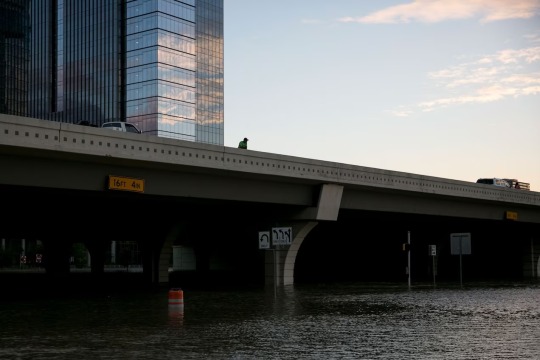
Streets were flooded after Hurricane Harvey hit Houston in 2017. Photograph By Ilana Pancih-Linsmam, The New York Times/Redux
The United States’ 2.2-million-mile drinking water and 800,000-mile sewer system was developed in part in response to the widespread waterborne diseases of the mid nineteenth century, Kirchhoff says. Maintenance has lagged woefully behind since then; some older areas, including some cities in the northeast, still use century-old wooden pipes. And many more of our pipes nationwide are still made of lead.
A water system designed for yesterday’s climate and to filter yesterday’s contaminants is especially problematic in a world of increasing demand, fiercer and more frequent storms, and “forever” chemicals. The result: boil orders, water main breaks, and sewer overflow, plus 15 percent of our water treatment plants working at or over capacity. These issues, combined with the toxicity of lead pipes, lead to water crises like the one that continues to plague Flint, Michigan.
Amlan Mukherjee, the director of sustainability focusing on infrastructure at WAP Sustainability Consulting, recommends focusing on these pipes—swapping lead for PVC or other materials and fixing the leaks that spill some 6 billion gallons of treated water a day—as one high priority fix.
Our coastline is also dotted with facilities storing hazardous oil and other chemical waste cocooned in donut-shaped earthen structures, adds Bilal Ayyub, a professor of civil and environmental engineering at the University of Maryland at College Park—structures that, he notes, could be made of concrete. Because of soil’s vulnerabilities, he worries that dramatic rainfall or a storm surge could destroy these structures, resulting in a release of toxic chemicals “bigger than the Exxon Valdez spill by orders of magnitude.”
His worst-case scenario has already happened at least once, when floodwaters from Hurricane Harvey ate through the earthen container at the San Jacinto River Waste Pits, releasing noxious waste into a nearby river.
Physical Collapse is Happening Now
Meanwhile, the number of high-hazard-potential dams in the United States now tops 15,000. Many were built during or before the WWII era and have been widely neglected since then. And when it comes to bridges, “there are cautionary tales all over,” says Maria Lehman, president of ASCE and vice chair of the Biden Administration’s National Infrastructure Advisory Council. “Every county in the country has a list of bridges that, if they had money, they would replace tomorrow.”
Our 617,000 bridges include not just those spanning mighty rivers but also every highway overpass and minor link across a stream—and close to one tenth of them are significantly compromised. “If you have to think in terms of catastrophe, we’re already there,” Mukherjee says. In 2007, the collapse of an I-35W bridge in Minnesota killed 13 people and injured 145. More recently, a six-lane bridge over the Mississippi was closed for three months in 2021, disrupting interstate travel and shipping because an inspector missed a significant crack. Americans drive 178 million trips on structurally deficient bridges each day.

Every day, millions of Americans travel across bridges and overpasses, like the Marquette Interchange in Milwaukee, that may be structurally deficient. Photograph By Keith Ladzinski, National Geographic Image Collection
Yet the US spends only 1.5-2.5 percent of its GDP on infrastructure, proportionately less than half of what the European Union spends, Lehman says. This long-term lack of funding has run out the clock on many solutions. Many of our bridges were built to last 30-50 years, but nearly half are at least half a century old. The average age of our levees is also 50; our dams average 57.
Now, extreme weather is intensifying just as structures fail. We’ve already seen consequences in the devastation of Hurricane Katrina in 2005, for example, when collapsing levees inundated 80 percent of New Orleans, killing hundreds, or in the failure of an under-inspected dam in Edenville, Michigan, which flooded the region and destroyed thousands of homes in 2020. The trend is set to continue: after Superstorm Sandy engulfed New York City transit, Ayyub helped study similar risks in Washington, D.C and Shanghai. His models showed widespread flooding that could swamp D.C. metro stations and in severe cases even reach “the backyard of the White House.”
The Future of U.S. Infrastructure
Mukherjee is optimistic about the use of new technology to solve some of these issues, though adoption has been slow. Drones can provide human inspectors with up-close views of areas they can’t reach themselves and reduce chance of human error; a drone on an unrelated project captured footage of the Mississippi bridge crack two years before its discovery.
Ayyub has also worked with North American freight railroads to find weak links using computer modeling, combing through thousands of stations to “identify exactly which point if it fails will have the biggest impact,” he says. Why not do the same with our power grid and waterways?
One piece of good news: in 2021, Congress passed the Bipartisan Infrastructure Law, which provides $1.2 trillion over five years for the ailing systems that help American society run, the largest federal investment in US history. It was a major victory. “Every president for the last eight presidents said we should spend a lot of money—like a trillion dollars—on infrastructure, and none of them delivered,” Lehman says.
Unless it is renewed regularly, though, this funding will barely stop the bleeding. And meanwhile, across the country, families like Kirchhoff’s (who after a difficult year were able to rebuild both the destroyed houses) struggle to recover from a relentless march of disasters, many of them preventable. It’s time for the US to learn the lessons drawn from of a century of neglect, Lehman argues, and begin maintaining the systems that makes so much of American life possible while they’re still in working condition.
“If you have a leak in your roof, you go up there, find it, replace the shingles, put on a little tar” she says. “If you let it go, it’s not going to be a little fix: it’s going to be a replacement.”
#US 🇺🇸#Infrastructure#Alissa Greenberg#Engineers#Christine Kirchhoff#Environmental Engineering#Pennsylvania State University#American Society of Civil Engineers#Contamination#Bilal Ayyub#University of Maryland#Amlan Mukherjee#Exxon Valdez#Hurricane Harvey#Biden Administration’s National Infrastructure Advisory Council#Mississippi River#European Union 🇪🇺#Hurricane Katrina#New Orleans#Superstorm Sandy#New York City#Washington D.C.#White House#Infrastructure Law
3 notes
·
View notes